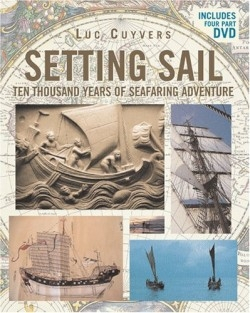
Setting Sail
Ten Thousand Years of Seafaring Adventure
There is no record of where or when the first boat was built, according to the author. That question is somewhat irrelevant anyway, he points out, since different people in different places gradually developed watercraft, using trees, reeds, or other material that provided buoyancy. With the onset of what Cuyvers terms “organized life” 10,000 years ago, boats and rafts began taking on an additional role. Rather than being merely a means of getting from one place to another, boats could also carry goods and supplies.
This book, with its corresponding DVD (which is part of a four-hour documentary on the subject of seafaring history to be shown in the fall on the Discovery Channel Network), chronicles the maritime history of “some important non-Western cultures.” An example is the Australoid people, now known as Melanesians. From their homes in Indonesia and possibly the Philippines, the Austronesians began their eastward thrust in the Pacific along the north coast of New Guinea, probably following the routes initiated by the first migrants thousands of years earlier. At first, Cuyvers explains, they reached places already occupied by Melanesian inhabitants. If there was sufficient food and space, they apparently cohabited peacefully, but with land, fresh water, and other resources at a premium, the Austronesians sailed on and reached uninhabited islands further east.
Cuyvers, who is Belgian, writes and produces televisio
n documentaries about the sea, as well as books like Into the Rising Sun: Vasco da Gama and the Search for the Sea Route to the East, the companion book to the 1998 PBS documentary “Into the Rising Sun.” He received his doctorate in marine studies from the University of Delaware and has authored six other books on marine issues.
Here, he explains that each culture made its own adjustments to particular challenges of water travel. The Austronesians and Polynesians invented swift catamarans and unique navigational techniques. The sailors of the Middle East and Indian Ocean probably conceived the lateen sail, although similar designs may have been developed independently in Southeast Asia.
After thousands of years, the era of commercial sailing is coming to a close, a trend that began when steam engines started to replace masts and rigging in the middle to late nineteenth century. Sailing held on in some places for another fifty to one hundred years, and in a few places is a viable enterprise even today.
Other books have been written on the history of seafaring, but Cuyvers’s reveals as much about the people as it does about their ships, explaining the goals of their voyages when such knowledge is accessible. His lucid introduction further enriches this well-researched, concisely written book that will appeal to both scholars and casual readers. The author’s fervor for his subject is evident on every page.
Reviewed by
George Cohen
Disclosure: This article is not an endorsement, but a review. The publisher of this book provided free copies of the book to have their book reviewed by a professional reviewer. No fee was paid by the publisher for this review. Foreword Reviews only recommends books that we love. Foreword Magazine, Inc. is disclosing this in accordance with the Federal Trade Commission’s 16 CFR, Part 255.
